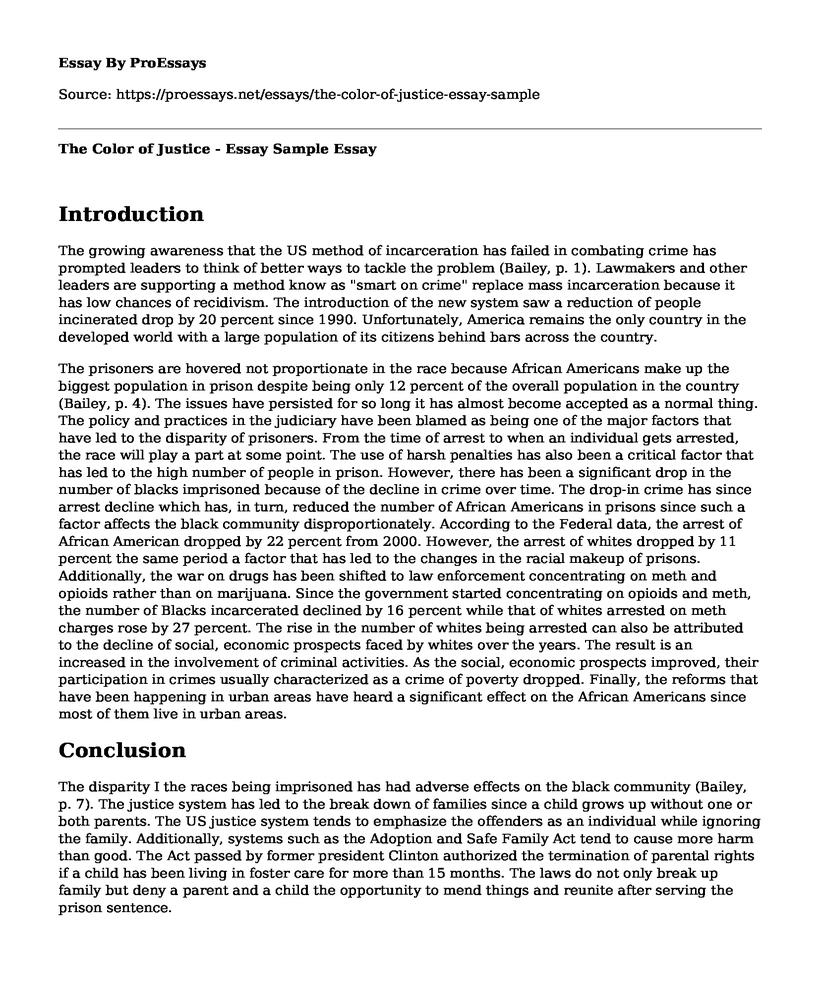Introduction
The growing awareness that the US method of incarceration has failed in combating crime has prompted leaders to think of better ways to tackle the problem (Bailey, p. 1). Lawmakers and other leaders are supporting a method know as "smart on crime" replace mass incarceration because it has low chances of recidivism. The introduction of the new system saw a reduction of people incinerated drop by 20 percent since 1990. Unfortunately, America remains the only country in the developed world with a large population of its citizens behind bars across the country.
The prisoners are hovered not proportionate in the race because African Americans make up the biggest population in prison despite being only 12 percent of the overall population in the country (Bailey, p. 4). The issues have persisted for so long it has almost become accepted as a normal thing. The policy and practices in the judiciary have been blamed as being one of the major factors that have led to the disparity of prisoners. From the time of arrest to when an individual gets arrested, the race will play a part at some point. The use of harsh penalties has also been a critical factor that has led to the high number of people in prison. However, there has been a significant drop in the number of blacks imprisoned because of the decline in crime over time. The drop-in crime has since arrest decline which has, in turn, reduced the number of African Americans in prisons since such a factor affects the black community disproportionately. According to the Federal data, the arrest of African American dropped by 22 percent from 2000. However, the arrest of whites dropped by 11 percent the same period a factor that has led to the changes in the racial makeup of prisons. Additionally, the war on drugs has been shifted to law enforcement concentrating on meth and opioids rather than on marijuana. Since the government started concentrating on opioids and meth, the number of Blacks incarcerated declined by 16 percent while that of whites arrested on meth charges rose by 27 percent. The rise in the number of whites being arrested can also be attributed to the decline of social, economic prospects faced by whites over the years. The result is an increased in the involvement of criminal activities. As the social, economic prospects improved, their participation in crimes usually characterized as a crime of poverty dropped. Finally, the reforms that have been happening in urban areas have heard a significant effect on the African Americans since most of them live in urban areas.
Conclusion
The disparity I the races being imprisoned has had adverse effects on the black community (Bailey, p. 7). The justice system has led to the break down of families since a child grows up without one or both parents. The US justice system tends to emphasize the offenders as an individual while ignoring the family. Additionally, systems such as the Adoption and Safe Family Act tend to cause more harm than good. The Act passed by former president Clinton authorized the termination of parental rights if a child has been living in foster care for more than 15 months. The laws do not only break up family but deny a parent and a child the opportunity to mend things and reunite after serving the prison sentence.
Cite this page
The Color of Justice - Essay Sample. (2022, Apr 28). Retrieved from https://proessays.net/essays/the-color-of-justice-essay-sample
If you are the original author of this essay and no longer wish to have it published on the ProEssays website, please click below to request its removal:
- Women and Crime Essay Example
- Criminal Justice Assignment: Murder of Notorious B.I.G. Florence - Marie Cooper
- Essay Sample on Health Issues for Refugees
- Is a Higher Standard Needed for Campus Sexual Assault Cases? - Essay Sample
- Essay on Weight Loss Intervention for Obese and Overweight Children and Adolescents
- Crime and Justice: A Systematic Analysis
- Hate Crime Laws Paper Example







